Index • FIDE 1948-1990 • Pre-FIDE • Highlights • Best games • News/Feedback • Gifts • Site map
World Chess Championship
|
||
We have sometimes wondered if the first drawn 1909 match wasn't a setup by Lasker to raise the hopes of Janowski's financial backers, thereby enticing them to finance a longer match. This, of course, is only wild speculation. This article is an attempt to analyze the games and determine if the speculation has any validity.
This analysis is in no way meant to malign Lasker. He has always been one of our favorite players and we are in no position to understand the depth and originality of his play. It is possible, however, that financial considerations overcame chess ethics in this match.
Indeed, Lasker's ethics have long been under the shadow of doubt. It is suspected that he avoided challenges from the strongest title contenders and that it was primarily for this reason that he remained the World Chess Champion for 26 years, a record which no other player has come close to breaking.
Our speculation runs into a first hurdle when we notice that Lasker won the first game of the match. But let's take a closer look.Lasker didn't win this game; Janowski lost. What do we mean? Take a look at the following pawn sacrifice. After 20...dxe5 21.f5, White has a nice e4 square for his knights, but is that worth the pawn?
| Game 1 : Janowski - Lasker |
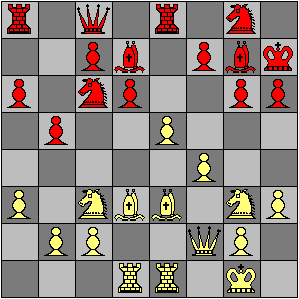
|
| after 20.e4-e5 |
|
|
Later in the game, Janowski played 35.Nb3 in this position, and Lasker answered 35...Qf7, threatening both ...Qxb3 and ...f4. Oops!
| Game 1 : Janowski - Lasker |
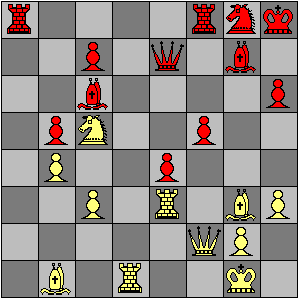
|
| after 34...Re8-a8 |
|
|
With Lasker leading 1-0 after the first game, another win would have ended Janowski's chances in the short four game match. Let's look at the second game in a little more detail.The first interesting position arose in the middle game. Lasker has some advantage with the knight on e4, but Janowski has counterplay on the open f-file. Why did Lasker play 27.Qe2 here? He has been preparing c4-c5 and it seems that 27.Rd1, which he played on his next move, would have been more consistent. Is the queen placed better on e2 than on c2?
| Game 2 : Lasker - Janowski |
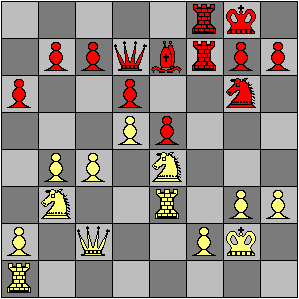
|
| after 26...Raf8 |
|
|
Lasker made another curious move a few moves later, when he played 34.Rcd3 in the following position. Why? The d5 pawn isn't in any danger. It seems that the position requires opening the queen side, where White is stronger. One active possibility would be 34.a4 bxa4 35.Na5 Nd4 36.Qxa6.
| Game 2 : Lasker - Janowski |
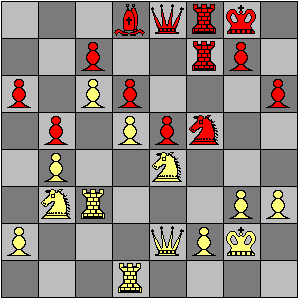
|
| after 33...h7-h6 |
|
|
Here Lasker played 39.Kh1, but 39.Kh2, guarding the g and h pawns, is more natural. This is even clearer after 39...Nf5 40.Qg2, which shows that White wasn't leaving the h2 square for his queen.
| Game 2 : Lasker - Janowski |
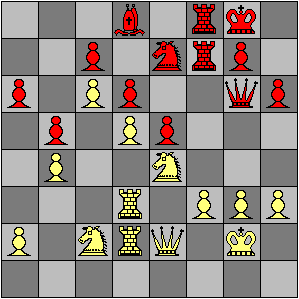
|
| after 38...Rf4-f7 |
|
|
In the following position, Lasker has just won an exchange for a pawn, but Janowski has compensation in the the well posted knight and the weak White pawns. Lasker played 54.Re3, which lost another pawn after 54...Qb1+ 55.Kh2 Qxb4.Why not 54.Rd1? If 54...Nc2 55.Rf1 Qd3 56.Qf2, White's attack on the f-file should be enough for a perpetual check and perhaps even a checkmate. But Black has 54...Qg4 55.Rf1 Nf5 56.Rf3 h4, which also wins another pawn. Finally, if 54.Ra3, ...e4 is strong.
| Game 2 : Lasker - Janowski |
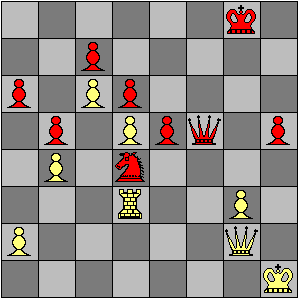
|
| after 53...Qf7-f5(xR) |
|
|
It seems that Lasker's move was the strongest after all. Returning to the game continuation, we see that Lasker regained the pawn after 56.g4 h4 57.Kh3, but Janowski drove his b-pawn to b1, supported it with the knight, promoted it to a queen, and won.
Janowski was lucky in that although having lost the exchange, his compensation was enough to give him strong counterplay, perhaps even an advantage. Did Lasker foresee this when he won the exchange? We think not.
Now let's look at the third game. At this point the match was tied 1-1. In the following position, Lasker played 19...Nb6. Why? White is building a kingside attack, but the knight moves away from the center of action. On b6, the piece threatens nothing, defends only against Qc4, or offers to exchange knights after Nc4.There is some possibility that Black can use the vacated d7 for ...Qd7 or ...Ra8-d8-d7. A few moves later, after White played c4 and d5, Black played 23...Nb6-d7 to occupy the hole on e5, thereby losing two tempi.
| Game 3 : Janowski - Lasker |
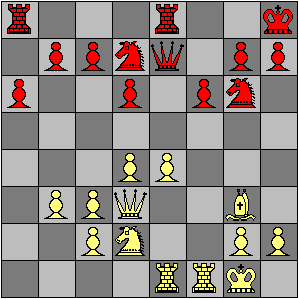
|
| after 19...Ra1-e1 |
|
|
In this position Lasker played 35...g5 and lost material after 36.Rf5 gxh4 37.Nxh5 Qxh5 38.Rxh5+ Rxh5 39.Qh3.
| Game 3 : Janowski - Lasker |
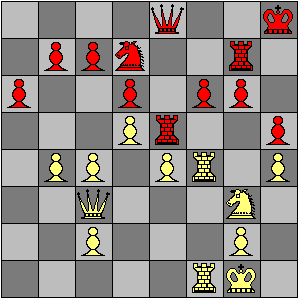
|
| after 35.Qf3-c3 |
|
|
Is there no better move than ...g5 in the position? White is clearly better, but making a hole on f5 does not seem to be an efficient way to defend. Why not play a waiting move? Another possibility is ...c5, to prevent Ng3-e2-d4-e6.
Trailing by 2-1, Lasker played a very powerful game to even the match at 2-2. Five months later, he completely dominated Janowski in a longer match, winning with a score of +7-1=2.Another consequence of our speculation is that Lasker must have been confident enough of his chances against Janowski to assume that he could win at will.
Lasker's style is notoriously difficult to understand and there are many examples of his playing inferior moves to throw his opponent off-balance psychologically. Perhaps in this match his psychological strategy simply backfired.
With the exception of 39.Kh1 in the second game, every one of the moves we've flagged above could indeed have been chosen by a strong master, especially for psychological reasons. Our conclusion is that Lasker played the games at full strength and that Janowski was somewhat lucky to draw this match against the reigning world champion.
|
WCC Index |
Positions etc. |